Alongside Silicon Valley engineers and software developers, artists explore new technologies
By Melissa Hart

This May, artist Andrea Blum wandered through the woods of Marin County collecting plants, insects, and lichen. Then, she headed for Autodesk’s steel-and-glass Pier 9 studio in San Francisco to cook the natural materials into a dye, which she’d later use to color pieces of felt. She cut the felt according to a design she’d made with the company’s 123D Make software and layered the purple, brown, and gold squares between wood that she’d cut and milled in the studio. Finally, she used an Omax water-jet cutter with 55,000 psi of water to cut the layers into circles and cake-like wedges.
“They’re ecosystem-based cake stands—color maps of specific places and ecosystems where I tend to forage for certain foods,” Blum explains of her creation. “[The ecosystem] is very much a part of my philosophy around the table and cooking—that is, ecosystem eating and really knowing where your food comes from.”
Autodesk, a multinational software corporation, inspires Blum, who is also a chef and food entrepreneur, to think beyond hand-crafting objects and to consider using machines to do things she can’t do with her hands. “Machines push your imagination further,” she explains.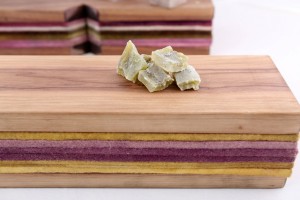
Blum is an artist in residence at Autodesk, one of several artists and fabricators who receive a monthly stipend to create side by side with programmers and engineers at the Pier 9 workshop on the San Francisco waterfront. In the past few years, high-tech companies all across Silicon Valley have recognized the creativity and collaboration that emerge when they invite visual artists to use cutting-edge software and machines such as 3-D printers and water-jet cutters.
Vanessa Sigurdson, Autodesk’s Artists in Residence program manager, appreciates the mutual inspiration that occurs when tech meets art. “We’re all about inspiring others to make things and ask questions and share their work,” she says.
INNOVATION AT ALL LEVELS
Autodesk offers four-month residencies to artists and fabricators who want to take advantage of the digital-fabrication workshops with high-tech equipment and cutting-edge software. Some residents arrive with a project in mind, and others explore the tools and then begin creating new work. They meet other artists and staff at company-hosted dinners and take classes on how to use the tools. Once they’ve taken those classes, Sigurdson says, they can get to work. Artists document their process along the way and post photos of their work on the website instructables.com. At the end of their residencies, they present their projects to a crowd of as many as 100 people who pack the Pier 9 office space.
Staff and supporters flocked to see, for example, artist Wei Li’s “Dangerous Popsicle” project. Li created silicone models in Rhino 3-D computer graphics and computer-assisted-design application software; printed them on a Stratasys Objet 3D printer; and then produced frozen desserts in the shape of cacti and viruses, including MRSA (methicillin-resistant Staphylococcus aureus), influenza, and HIV. A video on Vimeo shows grinning participants taking cautious licks of the colorful popsicles in a decidedly celebratory atmosphere.
“The staff is incredibly knowledgeable,” Blum says of her Autodesk cohorts. “There are electrical and mechanical engineers, rocket scientists, all kinds of people. [The company has] one of the biggest and most pristine machine shops in the country—a place in which you can really push your boundaries.”
Employees at Autodesk, in turn, find themselves challenged. By working with artists who use the software and machines in innovative ways, they’re inspired to extend the boundaries of the software they’re developing.
Artist in residence Andreas Bastian came to Autodesk to create work on a metal-laser-printing machine and became one of the company’s 3-D printing research scientists. Bastian is also involved with e-NABLE, an online community that creates low-cost 3-D-printed prosthetics for children. “The residency took him to a place that allowed him to explore what he’s passionate about,” Sigurdson says. “He gets to work on this project that helps a lot of people.”
Blum says that Autodesk employees often come by Pier 9’s commercial test kitchen or the water jet to offer high-fives and to watch her progress on the ecosystem-based cake stands. “People get excited about what I’m doing,” she says. “It’s an amazing creative process.”
Blum is thriving as an artist in Autodesk’s collaborative learning environment, informed by San Francisco’s “maker” culture. (The Maker Faire that occurs each May attracts approximately 65,000 people.) “Innovation happens at all levels,” she says. “It’s not just from the top down. All of us make stuff. It’s fantastic to be in an atmosphere that celebrates those who make things, and then you share your knowledge so that people can take it further.”
CREATIVITY IN CORPORATE CULTURE
Blum discovered Autodesk’s Pier 9 program through an artist she met at another residency—this one through the Montalvo Arts Center in Saratoga, California. Montalvo, which offers five studios and a gallery on 175 acres in the heart of Silicon Valley, offers one- to three-month fellowships to 60 artists a year. Fellows may find themselves working in collaboration with professionals at Sun Microsystems and other local high-tech companies. “They have lots of opportunities to meet people at companies interested in this spark of creativity, and [who are] looking for how to bring it back into their corporate culture,” says Kelly Sicat, director of the Lucas Artists Residency Program at Montalvo.
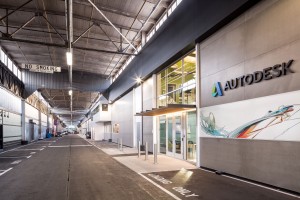 She mentions new-media artist Daniel Canogar, who worked as a Montalvo fellow and connected with Palo Alto, California, venture capital group The Hive to become part of the group’s think tank. The company is also supporting another fellow who’s doing a residency program with the SETI (Search for Extraterrestrial Intelligence) Institute—a nonprofit scientific and educational organization dedicated to exploring and explaining the origin and nature of life in the universe. SETI artists work with scientists to investigate how humans think and communicate. “There are a lot of ways in which artists can become a conduit for information and understanding between tech and science, between the academic sector and your average citizen,” Sicat says.
She mentions new-media artist Daniel Canogar, who worked as a Montalvo fellow and connected with Palo Alto, California, venture capital group The Hive to become part of the group’s think tank. The company is also supporting another fellow who’s doing a residency program with the SETI (Search for Extraterrestrial Intelligence) Institute—a nonprofit scientific and educational organization dedicated to exploring and explaining the origin and nature of life in the universe. SETI artists work with scientists to investigate how humans think and communicate. “There are a lot of ways in which artists can become a conduit for information and understanding between tech and science, between the academic sector and your average citizen,” Sicat says.
ART IN THE WORKSPACE
Artist and illustrator Forest Stearns has set his sights on space. He decorates shoebox-sized satellites that Planet Labs in San Francisco releases into orbit. Stearns became the first artist in residence at the company, which is working to create a constellation of Earth-observing satellites that the company hopes will generate imagery that will enable innovative new approaches to agriculture and environmental monitoring.
Stearns met one of the founders of Planet Labs at a venture capital camp. “His satellite was really ugly,” he says. “I asked him if he’d seen the World War II bombers with girls painted on them and said, ‘Let’s paint on your satellite.’”
Instead of pinup girls, Stearns painted black-and-white illustrations of interwoven migratory animals. “There’s an octopus wrapped around the horns of a caribou and a penguin and a bald eagle,” says Stearns. “These satellites … fly around the world and take pictures and look for changes in large organic matter, [and they are] covered in animals that watch and hope that people will make better decisions. I wanted to have the first art show in space to be about respect and responsibility.”
The Planet Labs residency program’s directors look for artists who find inspiration in scientific exploration, artists who—like those in residence at Autodesk—like to collaborate with creators in the technology industry. They’re encouraged to work onsite in a studio space in the company’s office and conduct hands-on workshops. They exhibit their completed work in the Planet Labs office space.
“If you’re a serious company, you have to tap into markets where people are being visually overwhelmed by their devices all the time,” Stearns says about the vitality of art in the workspace. “You’d better be able to resonate on a personal level with your team and make sure your company is more valuable than the app they’re using. Humans are a mark-making species. It’s how we communicate. Art is about creating community and people feeling like they’re valued. When there’s big, beautiful artwork on our walls, it makes everyone feel good.”
CREATIVITY WITH A BUSINESS ANGLE
The staff and artists at Minted believe that art should appear on walls, paper, greeting cards, buttons, and home decor. Differing from traditional resident-artist programs, the company invites designers from around the world to propose artwork and collaborate on products online.
Mariam Naficy is founder and CEO of the San Francisco-based company. She says that inviting outside artists to participate in Minted’s mission offers a fresh, continually evolving perspective on product design. “People never feel threatened when an outsider comes in,” she explains. “The internal creative team likes having someone new to brainstorm with and provide inspiration.”
Typically, artists interested in working with Minted enter a virtual competition to propose their designs. Community members vote, and competition winners earn a virtual store in which they can exhibit and sell their designs. Georgia-based painter and creative stylist Kelli Hall initially channeled her creativity toward stationery and art before transitioning into a deeper relationship with the company.
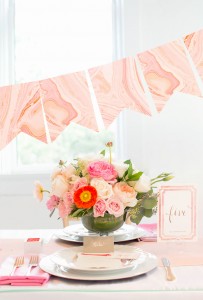 Minted created a stylist/photographer role for Hall and provided her with the technology and studio space to style photo shoots that display the company’s products. Her work has influenced the internal styling and design staff. “People want to learn from other talented, creative people,” says Naficy. “It’s been very successful and makes us want to extend this opportunity to more artists.”
Minted created a stylist/photographer role for Hall and provided her with the technology and studio space to style photo shoots that display the company’s products. Her work has influenced the internal styling and design staff. “People want to learn from other talented, creative people,” says Naficy. “It’s been very successful and makes us want to extend this opportunity to more artists.”
It’s an opportunity that Hall never expected to have when she graduated with a degree in fine art. “I thought I was destined to atrophy and make stuff and not find a real application for it,” she says. “Then I connected with Minted and started to realize this new platform. It’s reshaped the way that I think of opportunities for artists.”
Last summer, Hall styled a wedding shoot in an art gallery, pulling pieces of fine art into the scene and pairing them with watercolors and marbled papers that she’d made. “I collaborated a lot with creative directors at Minted and worked closely with the people making their products to make sure I was using them in a creative way,” she says.
The ability to bring her creative vision to life has been a unique experience. “It’s a rare thing to have this idea and be able to collaborate creatively from a business angle,” she says. “They give you the tools and resources to pull it off; it’s just amazing.”
NEW IDEAS, PROJECTS & IDENTITIES
Back at Autodesk’s Pier 9 commercial kitchen, Blum stays late into the night working on her ecosystem-based cake stands and growing fabric from bacteria, yeast, and tea. She’s collaborating with a fashion designer from Denmark on a project involving the resulting sienna-colored material festooned with a pattern that looks like cells under a microscope. Her residency at Pier 9, she says, makes her ask questions about her identity, as well as how her work represents who she is.
Blum is currently working on a proposal that would allow her to stay longer at Autodesk. “They’ve really opened me up to new ideas and projects,” she said. “I hope I never have to leave.”
A Sampling of Artist-in-Residence Programs in Silicon Valley
Autodesk Pier 9 Artists in Residence Program
autodesk.com/artist-in-residence/home
Autodesk’s 4-month residency allows artists to work flexible hours at the Pier 9 location in San Francisco and offers a monthly stipend of $1,500.
Facebook Artist in Residence Program
facebook.com/artistinresidence
Artists are offered flexible residencies in various locations with a stipend.
Minted
minted.com
The company solicits artists year-round to submit designs to be sold on the website. Artists receive a portion of each sale and receive a virtual store
in which they can launch and sell their designs.
Montalvo Arts Center Lucas Artists Residency Program
montalvoarts.org/programs/residency
The center offers one- to three-month residencies at Montalvo’s Saratoga, California, location. Artists receive a one-time stipend of $1,500.
Planet Labs Artist in Residency Program
planet.com
Two- to three-month residencies
require artists to work three days
a week in the studio at Planet Labs’ office space in San Francisco. Artists receive a monthly stipend of $1,000.
The SETI Institute’s Artist in Residence Program
seti.org/artist-in-residence The Institute offers two-year terms
with flexible locations. Artists must generate their own funding.
Zero1 Fellowship Program
zero1.org/programs/fellowship
The program offers flexible residencies in various locations with a stipend.




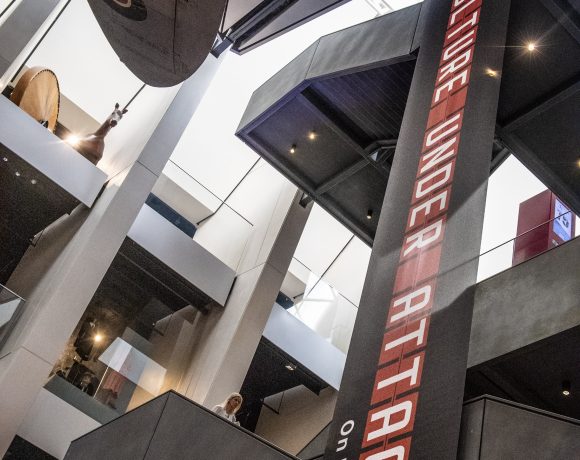

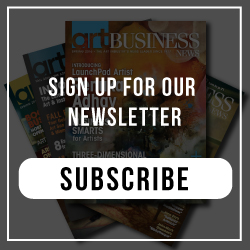


Adam Bockler
21 December
Thanks for your article about how cutting edge technology and art are being combined. My uncle owns a research company, and he often tries to get local artists to decorate or paint parts of his business using some of the tools that they have. I like how you talk about one artist getting to use a water jet cutter in order to “push her imagination further.” Having tools like this can really open different possibilities for industry and art.
Jerry Emanuel
3 November
What about artists creating in traditional media?